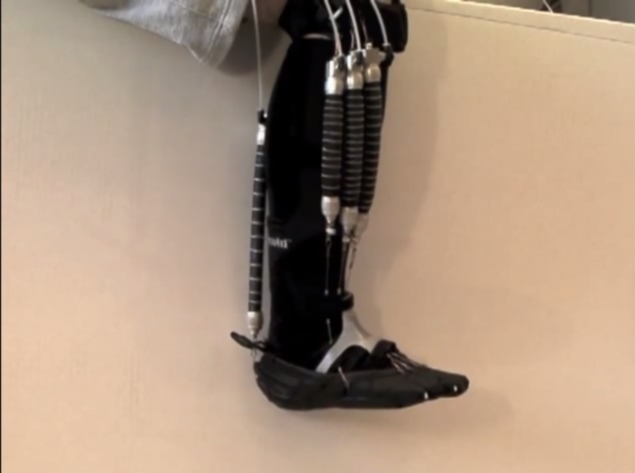- Home
- Others
- Others News
- Robotic device to heal bruised muscles
Robotic device to heal bruised muscles

Called robo-ankle, the device built by scientists at Carnegie Mellon University in the US can also assist people with more serious neuromuscular disorders like cerebral palsy and multiple sclerosis, said a report published in the New Scientist magazine.
"The device was originally meant for people with long-term conditions while it could also be used by those recovering from injury," said Yong-Lae Park, assistant professor at the robotics institute at Carnegie Mellon University in the US.
"The device could be used for short-term ankle rehabilitation as well, for example muscle training and exercise after cast or splint removal," he added.
Park and his colleagues built robo-ankle using soft plastics and composite materials, rather than a rigid exoskeleton.
The orthotic device includes pneumatic artificial muscles, small sensors and advanced
control software to mimic the muscles, tendons and ligaments of the lower leg.
The artificial muscles are controlled by compressed air and circuits, which move the wearer's foot through a series of exercise movements designed to strengthen weak muscles and improve the ankle's range of motion while the patient is sitting, added the report.
Future incarnations of the device may even allow for people to wear the device while going about their daily life.
"Controlling the device using the wearer's motion or muscle intention is our ongoing and future work," Park was quoted as saying.
Catch the latest from the Consumer Electronics Show on Gadgets 360, at our CES 2026 hub.
Related Stories
- Samsung Galaxy Unpacked 2025
- ChatGPT
- Redmi Note 14 Pro+
- iPhone 16
- Apple Vision Pro
- Oneplus 12
- OnePlus Nord CE 3 Lite 5G
- iPhone 13
- Xiaomi 14 Pro
- Oppo Find N3
- Tecno Spark Go (2023)
- Realme V30
- Best Phones Under 25000
- Samsung Galaxy S24 Series
- Cryptocurrency
- iQoo 12
- Samsung Galaxy S24 Ultra
- Giottus
- Samsung Galaxy Z Flip 5
- Apple 'Scary Fast'
- Housefull 5
- GoPro Hero 12 Black Review
- Invincible Season 2
- JioGlass
- HD Ready TV
- Laptop Under 50000
- Smartwatch Under 10000
- Latest Mobile Phones
- Compare Phones
- OPPO Reno 15 Pro Max
- Honor Win RT
- Honor Win
- Xiaomi 17 Ultra Leica Edition
- Xiaomi 17 Ultra
- Huawei Nova 15
- Huawei Nova 15 Pro
- Huawei Nova 15 Ultra
- Asus ProArt P16
- MacBook Pro 14-inch (M5, 2025)
- OPPO Pad Air 5
- Huawei MatePad 11.5 (2026)
- Xiaomi Watch 5
- Huawei Watch 10th Anniversary Edition
- Acerpure Nitro Z Series 100-inch QLED TV
- Samsung 43 Inch LED Ultra HD (4K) Smart TV (UA43UE81AFULXL)
- Asus ROG Ally
- Nintendo Switch Lite
- Haier 1.6 Ton 5 Star Inverter Split AC (HSU19G-MZAID5BN-INV)
- Haier 1.6 Ton 5 Star Inverter Split AC (HSU19G-MZAIM5BN-INV)















